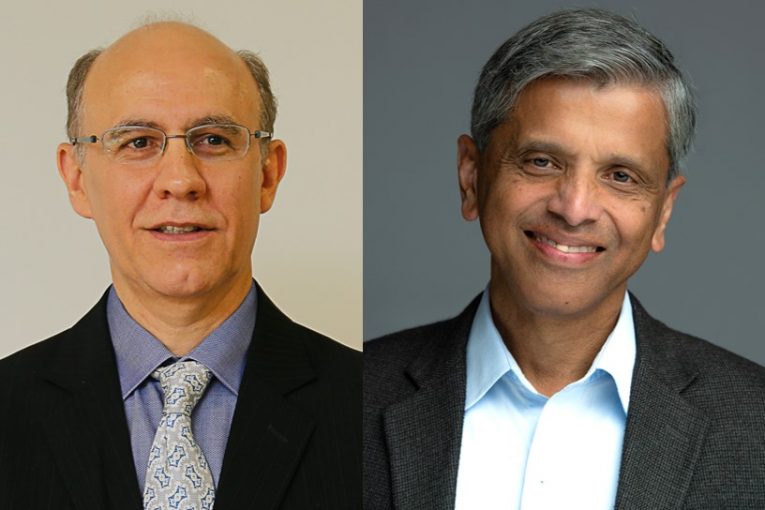CINE introduces the new members of its International Advisory Board.

Two prominent scientists joined CINE’s International Advisory Board (IAB) in October this year. These are Prof. Prashant V. Kamat (University of Notre Dame, USA), Editor-in-Chief of ACS Energy Letters, and Prof. Osvaldo Novais de Oliveira Junior (IFSC-USP, Brazil), Executive Editor of ACS Applied Materials & Interfaces.
Kamat and Oliveira Junior join four other renowned scientists who already serve as members of the board: Prof. Michael F. Toney (University of Colorado Boulder, USA), Nguyen Minh (research scientist at the University of California San Diego’s Center for Energy Research, USA), Prof. Su-Huai Wei (Beijing Computational Science Research Center, China) and Prof. James Durrant (Imperial College London, UK).
With the expertise of its members, the IAB guides CINE, being responsible, together with the Executive Committee, for preparing general guidelines for the Center and analyzing the goals of its key projects.
About the new members of the International Council.
Prashant V. Kamat is a Rev. John A. Zahm, C.S.C., Professor of Science in the Department of Chemistry and Biochemistry and Radiation Laboratory at the University of Notre Dame. He is also a Concurrent Professor in the Department of Chemical and Biomolecular Engineering. He earned his doctoral degree (1979) in Physical Chemistry from the Bombay University, and postdoctoral research at Boston University (1979-1981) and University of Texas at Austin (1981-1983). He joined Notre Dame in 1983. Professor Kamat has for more than three decades worked to build bridges between physical chemistry and materials science to develop advanced nanomaterials that promise cleaner and more efficient light energy conversion.
He has directed DOE funded solar photochemistry research for the past 35 years. In addition to large multidisciplinary interdepartmental and research center programs, he has actively worked with industry-sponsored research. He has served on many national panels on nanotechnology and energy conversion processes. He has published more than 450 scientific papers that have been well recognized by the scientific community (70,000 citations, h-index 135 – source Web of Science). Thomson-Reuters has featured him as one of the most cited researchers each year during 2014-2020.
He is currently serving as the Editor-in-Chief of ACS Energy Letters. He has also served as the deputy editor of the Journal of Physical Chemistry Letters. He is a member of the advisory board of several scientific journals (Chemical Reviews, Journal of Colloid & Interface Science, ACS Applied Nanomaterials, NPG Asia Materials, Research on Chemical Intermediates, and Applied Electrochemistry). He was awarded Honda-Fujishima Lectureship award by the Japanese Photochemical Society in 2006, CRSI medal by the Chemical Research Society of India in 2011 and Langmuir lectureship award in 2013. He is a Fellow of the Electrochemical Society (ECS), American Chemical Society (ACS), American Association for the Advancement of Science (AAAS) and Pravasi Fellow of the Indian National Science Academy.
Osvaldo N. Oliveira Jr. is a professor at the São Carlos Institute of Physics, University of São Paulo, Brazil. He obtained his BSc and MSc from the University of São Paulo, a PhD from the University of Wales, Bangor (1990), and an honorary doctorate (Honoris Causa) from the Federal University of Mato Grosso do Sul in 2019. Prof. Oliveira is a member of the Latin American Academy of Sciences, a former president of the Brazilian Materials Research Society, and Executive Editor of ACS Applied Materials & Interfaces.
He has led research into the fabrication of novel materials in the form of ultrathin films obtained with the Langmuir-Blodgett and self-assembly techniques. Most of this work has been associated with fundamental properties of ultrathin films with molecular control, but technological aspects have also been addressed in specific projects. This is the case of an electronic tongue, whose response to a number of tastants is considerably more sensitive than the human gustatory system. In recent years, Prof. Oliveira has pioneered the combined use of methods from distinct fields of science, with the merge of methods of statistical physics and computer science to process text, and use of information visualization to enhance the performance of sensing and biosensing. This pioneering work is associated with the merge of nanotechnology with Big Data Analytics and machine learning, bound to yield developments in technology such as computer-aided diagnosis systems. Prof. Oliveira has also developed strategies for scientific writing, especially targeted for non-native users of English.
As of October, 2020, he published over 580 papers in international journals, 3 books, in addition to filing close to a dozen patents, which have received ca. 13,700 citations (h =55, Web of Science) and ca. 20,500 citations (h = 67, Google Scholar). He was awarded with the Scopus Prize from Elsevier in 2006 as one of the most productive Brazilian scientists.
(Photo of Osvaldo Novais de Oliveria Junior by Cecília Bastos).











